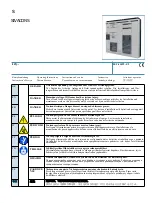
9365200990 Rev F
BE1-CDS240 Input and Output Functions
3-17
Table 3-8. Digital Input Conditioning Function Settings
Setting
Range
Increment
Unit of Measure
Default
Recognition Time
4 to 255
1
Milliseconds
4
Debounce Time
4 to 255
1
Milliseconds
16
Time Units
Pull-down menu that selects the unit of measure for
Recognition Time
and
Debounce Time
. Units of measure available are milliseconds (ms), seconds,
minutes, and cycles. The default is milliseconds.
Name
User programmable label for the input contact. Used by the reporting function to
give meaningful identification to the input contact. This label may be up to 10
characters long.
Energized State
User programmable label for the contact’s energized state. Used by the reporting
function to give meaningful identification to the state of the input contact. This
label may be up to seven characters long.
De-Energized
State
User programmable label for the contact’s de-energized state. Used by the
reporting function to give meaningful identification to the state of the input contact.
This label may be up to seven characters long.
If the user desires that the relay reject ac voltage that may become coupled into the contact sensing
circuits, the recognition time can be set to greater than one-half of the power system cycle period to take
advantage of the half-wave rectification provided by the input circuitry.
If the user desires to use an ac wetting voltage, the recognition time can be set to less that one-half of the
power system cycle period and the debounce timer can be set to greater than one-half of the power
system cycle period to ride through the negative half cycle. The default settings of 4 milliseconds
recognition and 16 milliseconds debounce time allow the relay to be used with ac wetting voltage at 60
Hz. A setting of 5 milliseconds recognition and 20 milliseconds would be used for 50 Hz.
Retrieving Input Status Information from the Relay
The status of the inputs can be determined by using BESTCOMS
Metering
screen, the optional HMI
using Screen 1.4.1, STAT\OPER\INPUT, and from the ASCII command interface using the RG-STAT
command. See Section 6,
Reporting and Alarm Functions, General Status Reporting,
for more
information.
OUTPUTS
BE1-CDS240 relays have ten or fourteen general-purpose output contacts (OUT1 through OUT14) and
one fail-safe, normally closed (relay in de-energized state), alarm output contact (OUTA). Each output is
isolated and rated for tripping duty. All relays outputs are high speed (one-quarter cycle nominal operating
time). OUT1 and OUT2 are Form C (single-pole, double-throw), OUTA is Form B (normally closed), and
all remaining OUT3 through OUT14 are Form A (normally open).
Hardware Outputs and Virtual Outputs
To operate a hardware output, OUT1 through OUT14 or OUTA, the hardware outputs must be driven by
one or more of the BESTlogic output expressions VO1 through VO14 and VOA (Virtual Outputs 1 through
14 and A). Since the use of each output contact is completely programmable, the user can assign
meaningful labels to each output, as well as, to the zero and one states. See Section 7,
BESTlogic
Programmable Logic,
for more information on programming output expressions in your programmable
logic scheme.
A virtual output (VOn) exists only as a logical state inside the relay. A hardware output (OUTn) is a
physical, output relay contact. The state of the output contact can vary from the state of the output logic
expression for several reasons: 1) the relay trouble alarm disables all outputs; 2) the programmable hold
timer function; 3) the select before operate logic override control function; or 4) a virtual output is not
assigned to a hardware output. Figure 3-9 shows a diagram of the output contact logic for the general-
purpose output contacts. Figure 3-10 shows a diagram of the output contact logic for the fail-safe alarm
output contact. Virtual output A, VOA is always assigned to the fail-safe alarm contact OUTA.
Summary of Contents for BE1-CDS240
Page 2: ......
Page 8: ...vi BE1 CDS240 Introduction 9365200990 Rev F This page intentionally left blank ...
Page 38: ...1 28 BE1 CDS240 General Information 9365200990 Rev F This page intentionally left blank ...
Page 40: ...ii BE1 CDS240 Quick Start 9365200990 Rev F This page intentionally left blank ...
Page 152: ...ii BE1 CDS240 Metering 9365200990 Rev F This page intentionally left blank ...
Page 226: ...iv BE1 CDS240 Application 9365200990 Rev F This page intentionally left blank ...
Page 286: ...ii BE1 CDS240 Security 9365200990 Rev F This page intentionally left blank ...
Page 290: ...9 4 BE1 CDS240 Security 9365200990 Rev F This page intentionally left blank ...
Page 292: ...ii BE1 CDS240 Human Machine Interface 9365200990 Rev F This page intentionally left blank ...
Page 306: ...10 14 BE1 CDS240 Human Machine Interface 9365200990 Rev F This page intentionally left blank ...
Page 308: ...ii BE1 CDS240 ASCII Command Interface 9365200990 Rev F This page intentionally left blank ...
Page 342: ...11 34 BE1 CDS240 ASCII Command Interface 9365200990 Rev F This page intentionally left blank ...
Page 349: ...Figure 12 5 Horizontal Rack Mount Front View 9365200990 Rev F BE1 CDS240 Installation 12 5 ...
Page 361: ...Figure 12 17 Typical DC Connection Diagrams 9365200990 Rev F BE1 CDS240 Installation 12 17 ...
Page 372: ...12 28 BE1 CDS240 Installation 9365200990 Rev F This page intentionally left blank ...
Page 468: ...13 92 BE1 CDS240 Testing and Maintenance 9365200990 Rev F This page intentionally left blank ...
Page 512: ...14 42 BE1 CDS240 BESTCOMS Software 9365200990 Rev F This page intentionally left blank ...
Page 544: ...ii BE1 CDS240 Terminal Communication 9365200990 Rev F This page intentionally left blank ...
Page 550: ...ii BE1 CDS240 Settings Calculations 9365200990 Rev F This page intentionally left blank ...
Page 578: ...D 28 BE1 CDS240 Settings Calculations 9365200990 Rev F This page intentionally left blank ...
Page 579: ......
















































